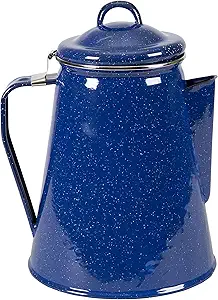My school of thought is the best coffee maker is you personally.
Now, sure, some people are mainly out for convenience and don't want to be bothered with all that. Coffee fills different roles in various people's lives. But for some of us who are trying to get the best flavor out of coffee that we can, yes your own skill is what makes the difference!
I'm still using $7 worth of Melitta pour over funnel. I don't tend to use it when I'm in my car, as I tend to drive around in warm weather. That could change if I was in more fall-like conditions, but the last time I was up for that, this thing called hurricane Helene intervened and ended the situation.
When I have a roof over my head, I boil my water in a 16 oz. glass Pyrex cup in a microwave, throwing a small glass bowl upside down on top of it as a "lid" / pouring restrictor. This is in preference to the various pricey gooseneck kettles out there. Some of which can impart bad flavors to coffee due to bad Chinese metals they're made with. This is borrowed gear and I haven't bought my own yet for the road. Glass is great for flavor and for a microwave, but not my favorite thing in a car.
The main sticking point in my technique is the quality of the coffee I'm buying. I have not yet invested in a grinder. I try to preserve the quality of coffee grounds longer by rolling the bag up like a tube of toothpaste, pressing whatever air out of it I can after I open it. Better coffee bags generally have valves on them, it's this round plastic insert thing. So all you have to do is close the bag and squeeze the air out. I've studied more elaborate vacuum methods, such as repurposing wine suckers and beer bottles, but it's not worth it to me yet.
When I'm on the road, I make cold brew. This fits well with my full sized cooler and the warm weather I'm typically traveling in. I don't buy coffee grounds, I buy whole beans. I grind them by hand, channeling my inner Ethiopian. My 1st grinding method was a fork and the bottom of a plastic container, resting on a hard surface like a picnic table. It works, but 2 ceramic bowls of different curvature work better. Basically a poor man's mortar and pestle. The point is there's zero barrier of entry for equipment. Once you're ready to spend a few dollars, you could get the bowls at Goodwill, or maybe even a dollar store.
You don't have to grind those beans down to anything fine. All you have to do is make sure they're broken. Whole beans have some kind of impermeable layer from the roasting. They won't brew. But if they've been broken, they will just fine. You can tell you've done a bad job if you have a "floater" in your bottle, after it's been in there for 24 hours. Nothing should be floating, it should all be sinking.
I use 10 oz. tonic water bottles to hold the brew. I like the thick glass, the grenade like feel of the things, and the plastic caps. I use filtered water gained from places like public libraries. Throw them in the cooler. 24 hours later, you've got cold brew.
So yeah the disadvantages are that this requires premeditation, and you have to be willing to exert some hand strength. But once you do that it's pretty reliable and predictable.
It's gonna come out about as well as the beans you bought. Don't buy bad ones. Check freshness dates. Don't believe in "stupid" sources of coffee, if you're after this for flavor. Like no, Trader Joe's isn't gonna sell you anything that's any good. Buy real coffee from somewhere. At a minimum you need some kind of snotty independent roaster. And some experience finding out if they actually deliver the goods, because regionals could just be putting a bunch of stale stuff in fancy bags.
I typically just sip and spit. Since my grind is mostly a bunch of broken beans, most of it stays at the bottom of the bottle. I could filter it though, especially "for company". Don't need any special filters for that. Cheap, incorrectly fitting basket filters, shoved into a funnel (like my Melitta) will work fine.




















